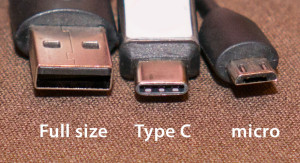USB

Universal Serial Bus
An industry-standard type of physical (wired) connection that carries both data and electrical power.
In a phone, USB is most commonly used as the charging connector. But it is also useful for reliably connecting phones to devices such as computers, TVs, and cars.
There are two standard types of USB connectors found in phones. Micro-USB was the most common until 2015, when Type-C starting replacing it, starting with high-end phones. By 2020, all but the cheapest phones come with modern Type-C connectors.
Both types are smaller than the full-size USB connector (Type-A) found on many computers and chargers. The most obvious feature of Type-C (also called just USB-C) is that it's physically reversible.
See: Micro-USB
See: USB Type-C
USB cables and adaptors are available with nearly any combination of the different connectors at each end, enabling simple compatibility between any two USB devices using different USB connectors.
Some devices (including Apple iPhones) support USB, but via a proprietary connector that requires a special cable to connect to other USB devices.
USB has several versions of its protocol, which is largely independent of the connector used. USB 2.0 is newer and potentially up to 40 times faster than USB 1.1. To benefit from the faster speed, the device must support "Hi-Speed" mode. "Full Speed 2.0" is a misleading marketing term that actually means slow speed (the same as USB 1.1.)
The newest version is 3.0. The fastest speed is "Super Speed", which is 10 times faster than Hi-Speed.
USB is designed to be backward-compatible. That means that newer devices support all older and slower versions of the protocol. Therefore any two USB devices can be connected, and will automatically use the best version of the protocol that both devices support. For example, a new USB 3.0 device connected to an old USB 1.1 device will automatically use USB 1.1 in order to be compatible.
A computer may require a special driver or other software to communicate with a phone over USB in a specific way. For example, not all computers support MTP and PTP modes for transferring photos and other media.
See: PTP
Alternatively, many phones support USB "mass storage" mode, which does not require any special drivers or software with modern computers, although this only supports file transfer.
See: Mass Storage mode
Some phones support USB-Host (also called USB-OTG), which allows USB accessories to be connected directly to a mobile device, the same way USB accessories can be connected to a computer.
See: USB OTG



